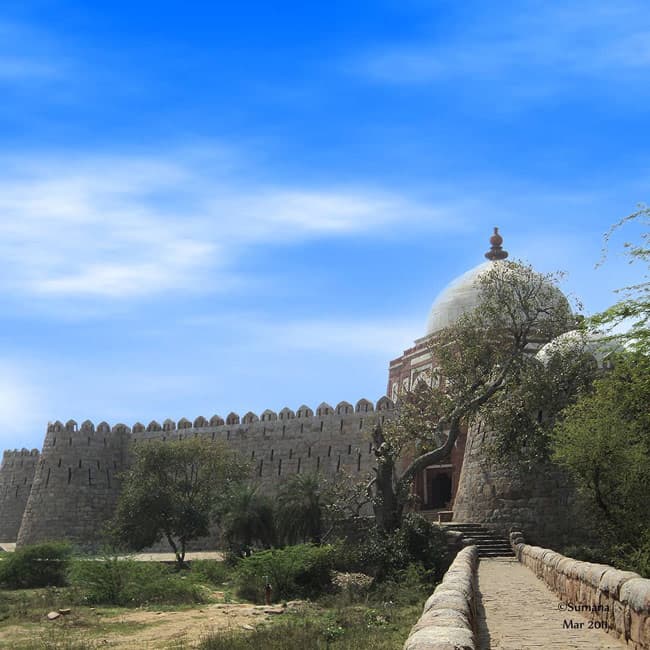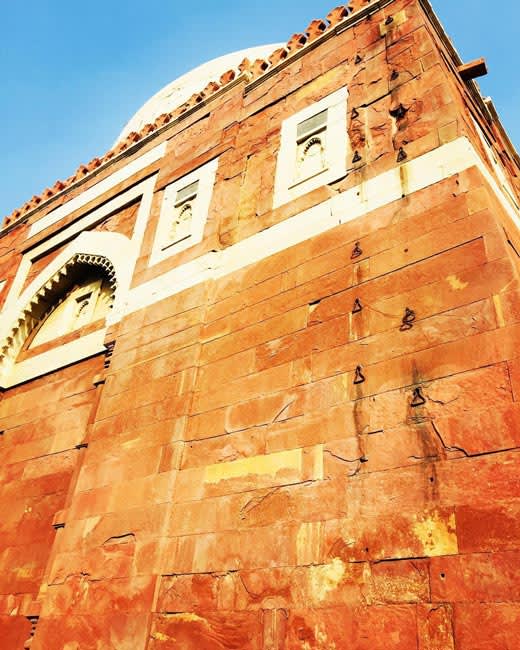 Delhi
DelhiDid You Know There's A Mausoleum Of Ghiyasuddin Tughlaq Next To The Tughlaqabad Fort?
Ghiyas-ud-din-Tughlaq died a supposedly cursed death, but his neat, trim mausoleum adjoining the massive ruins of Tughlaqabad Fort reveals nothing of the tragic story. Connected to the ramparts of the fort through a causeway now bisected by the Outer Ring Road, it’s a magnificent edifice of the rugged architecture of the Tughlaq period. The granite fortifications are contrasted by the red sandstone and white marble. There are three graves inside the square tomb, the central one belonging to Ghiyas-ud-Din himself, and the corner two are those of his wife Makh Dumai Jaan and second son, Mahmud Khan.
The Undoubted Curse

Picture Credits: sumanagraphy
Ghiyas-ud-Din was a pretty liberal ruler, but remained infatuated with his dream of a grand fortress and thereby set all the labourers under his wing to the task, some of whom were taken away from the construction of a stepwell for Saint Nizamuddin Auliya, one of the most important seers in the Indian Sufi movement. Miffed, the saint let out the now-famous curse, condemning the fortress to infertility or occupation by herdsmen.
Unperturbed, the king carried on his conquests. Returning from Bengal after a successful campaign, he was killed by a tent falling over him at Kara, Uttar Pradesh - allegedly ordered by the conspiring prince and successor Muhammad-bin-Tughlaq, who had come all the way to meet his father. The saint, having been asked to make way for the king’s return, had prophetically remarked ‘Hanooz Dilli Door Ust’ (Delhi is still far away).
The Structure

Picture Credits: sakshigupta
The exteriors are flat-faced inscribed red sandstones bordered by white marble, which also constitutes the central dome, resting on an octagonal platform. The lattice screens and ‘lotus-bud’ edges are another special feature. Another octagonal tomb flanks the Southern entrance, belonging to Zafar Khan, whose identity remains unknown. The interiors, though, are in a pretty dilapidated state compared to its counterpart. The central location of the tomb makes it visible from both the Tughlaqabad and Adilabad Forts. Like most other warrior tombs of that period, it juts out sloping outwards - aggressively.
Legend has it that the small tomb on the left side near the entrance belongs to the king’s favourite dog, but the thought seems a bit amusing. Like many other kings of the Delhi Sultanate, the king had planned the tomb before his death but paid heed to Zafar Khan’s tomb, which was present there beforehand. General Cunningham's diary records an artificial lake around the compound which could have served as a natural defence against intruders, but there is no sign of any water body around the entire area, even the seven water tanks inside the main fort now lie barren.
The monument lies next to the Outer Ring Road and can be easily accessed by half a dozen buses plying on that route. Asola Wildlife Sanctuary and Surajkund, another historical marvel, lie a little distance ahead.
Where | Mausoleum Of Ghiyasuddin Tughlaq - Adjoining The Tughlaqabad Fort, Tughlakabad
Like
Bookmark
Share

